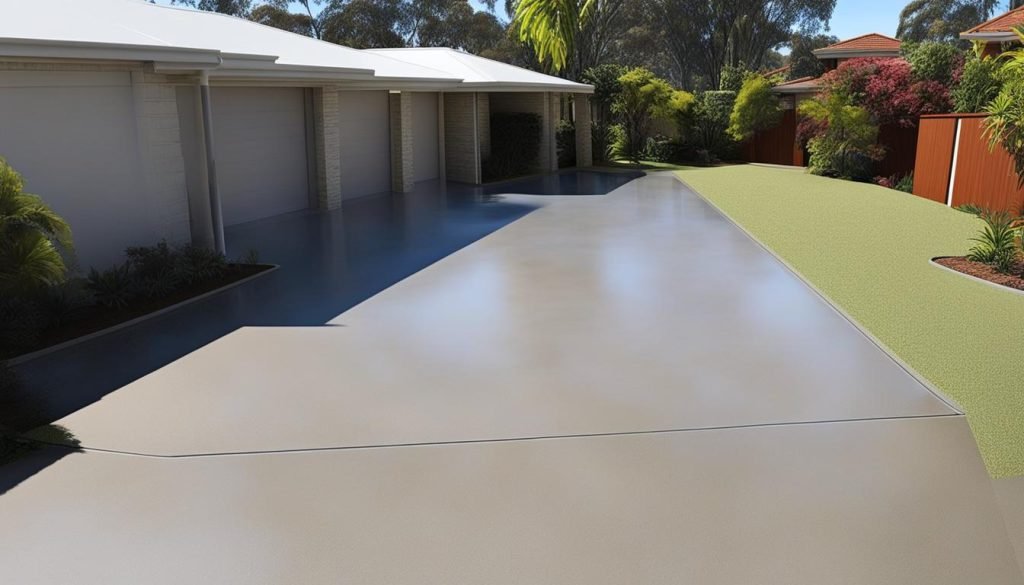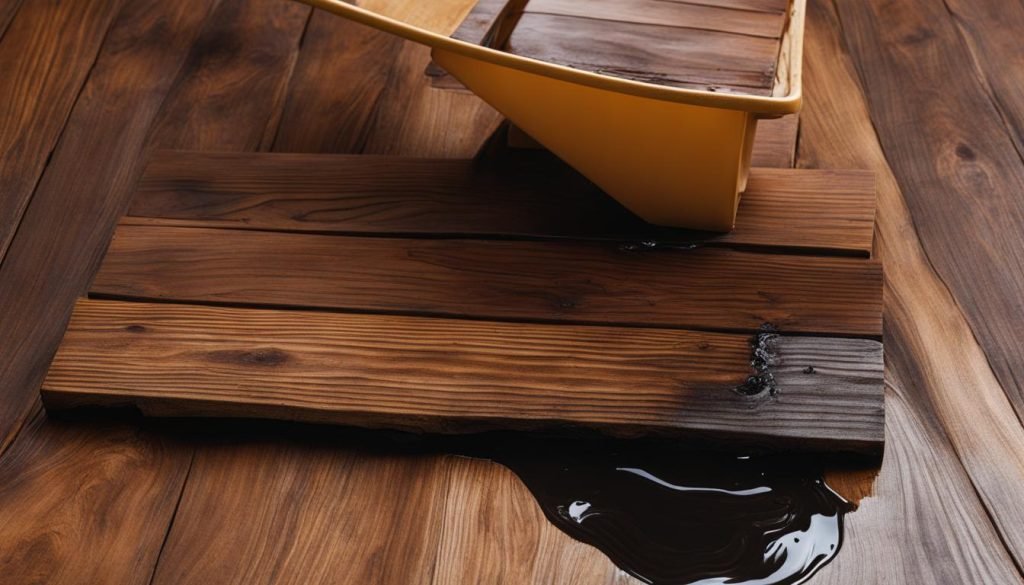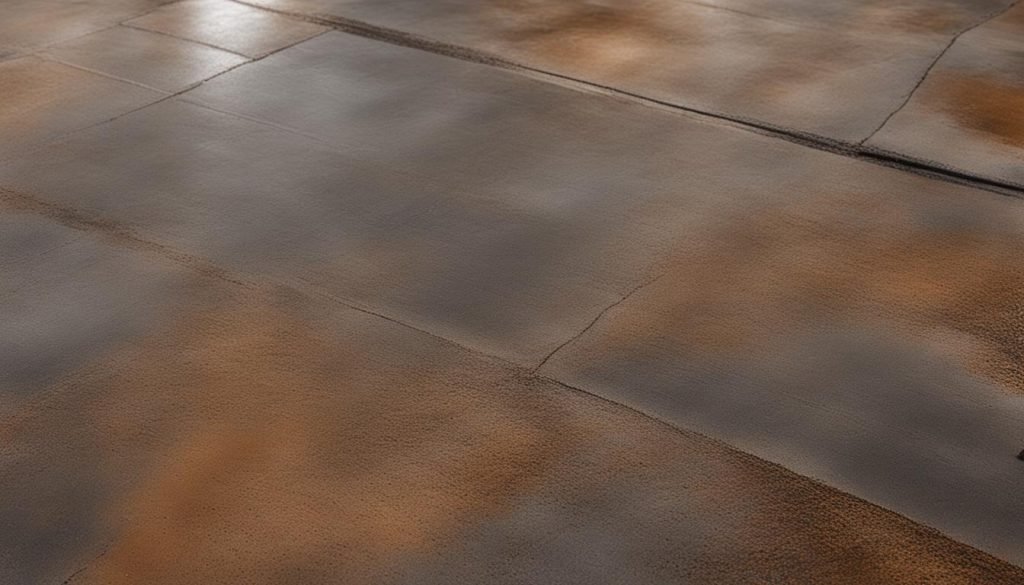Merbau wood is highly sought after for its durability and aesthetic appeal, making it a popular choice for decking timber. However, it can leave unsightly stains on surrounding concrete, caused by the discharge of sap and tannins from the timber. These stains can be difficult to remove, but with the right techniques, you can restore your concrete surfaces to their original condition. Click here for a Highly recommended concreting contractor in Toowoomba, known for excellence. If you’re looking to expand your construction skills, don’t miss this comprehensive guide on How to Build a Deck on Concrete Slab: Step-by-Step Guide. Gain valuable insights and step-by-step guidance for success in building a deck on a concrete slab.
If you’re wondering how to remove Merbau stains from concrete, there are two approaches you can take. The first is prevention, ensuring that the timber is thoroughly dried before installation. This can be achieved by allowing the tannins to drain naturally over several months or by using a pressure washer or deck cleaner to expedite the process. By taking these steps, you can minimize the likelihood of stains appearing on your concrete surfaces.
If stains have already set in, direct removal is the next step. One effective method involves using household bleach and a stiff brush to scrub the stained areas. Applying the bleach and vigorously scrubbing the stains will help erase them from the surface of the Merbau wood. This method is safe for both the timber and the surrounding concrete.
In conclusion, by following these methods and taking preventive measures, you can effectively remove Merbau stains from concrete and restore its pristine condition.
Key Takeaways:
- Preventing Merbau stains on concrete by ensuring thorough drying of the timber before installation is crucial.
- If stains have already appeared, using household bleach and a stiff brush can help remove them.
- Consider seeking professional assistance from Toowoomba Concreters for reliable and efficient stain removal services.
- Choosing low-tannin timber species or using tannin blocking primers can minimize the impact of tannin leaching.
- Properly coating and maintaining timber decks can help prevent tannin leaching and stains.
Understanding the Problem of Merbau Stains
Merbau wood, a popular choice for decking timber due to its durability and visual appeal, poses a challenge when it comes to stains. One of the main culprits behind these stains is the presence of tannins in Merbau wood. Tannins are water-soluble compounds that are released when the wood gets wet.
When Merbau timber is built on top of concrete or other surfaces, the oils and resins that leach out from the timber can leave unsightly stains. These stains are typically brownish in color, but Merbau wood exhibits a distinctive red-brown stain that can be particularly noticeable.
Although tannin leaching from Merbau timber is a temporary issue that tends to fade over time, persistent stains may require direct intervention for removal.
| Tannins in Merbau Wood | Leaching of Tannins from Merbau Timber |
|---|---|
| Tannins are water-soluble compounds present in Merbau wood. | Leaching of tannins occurs when the wood comes into contact with moisture. |
| Tannins can be released from the wood when it gets wet, leading to stain formation. | The release of oils and resins from the timber can leave stains on surrounding surfaces. |
| Tannin leaching from Merbau wood is a short-term issue that tends to fade over time. | If stains persist, direct intervention is required for removal. |
Preparing the Timber to Avoid Stains
To prevent Merbau stains from occurring, it’s important to ensure that the timber is thoroughly dried before installation. This can be done by allowing the tannins to drain naturally over several months or by using a pressure washer or deck cleaner to force the tannins out more quickly. By taking these measures before building with Merbau timber, you can minimize the likelihood of stains appearing on surrounding concrete or other surfaces.
Properly drying Merbau timber is essential to prevent tannin staining. The moisture content needs to be reduced to a certain level before installation to minimize the leaching of tannins. Here are some effective methods to prepare the timber:
- Natural Drying: Allow the timber to dry outdoors in a well-ventilated area for several months. This slow drying process allows the tannins to naturally drain out of the timber, reducing the risk of stains.
- Pressure Washing: Use a pressure washer with a gentle spray to wash the timber. This method helps to force out the tannins, speeding up the drying process. Ensure the pressure washer is set to a low-pressure setting to avoid damaging the timber.
- Deck Cleaner: Apply a high-quality deck cleaner specifically formulated to remove tannins from timber. Follow the manufacturer’s instructions and use a stiff brush to scrub the timber surface. Rinse thoroughly after cleaning.
Regardless of the method chosen, it is important to allow the timber to dry completely before proceeding with the installation process. This will help to minimize the release of tannins and reduce the risk of stains on surrounding surfaces.
By carefully preparing the Merbau timber and ensuring it is thoroughly dried, you can significantly reduce the chances of stains occurring. The next section will explore the various methods for removing stains from installed Merbau timber, in case stains do appear despite your preventive efforts.
Removing Stains from Installed Merbau Timber
If you have already built a structure using Merbau timber and stains are still appearing, there are methods for directly removing the stains. One effective approach is to use household bleach and a stiff brush to scrub the stained areas. Applying the bleach and scrubbing the stains vigorously will help to erase them from the surface of the Merbau wood. This method is safe for both the timber and the surrounding concrete or other materials. It’s important to note that persistent stains may require repeated treatment and scrubbing.
It’s important to use caution when working with bleach, as it can be harmful if not handled properly. Here are the steps to follow when using bleach to remove stains from Merbau timber:
- Prepare the area by thoroughly cleaning the stained surface. Remove any loose dirt or debris.
- Dilute the bleach with water in a 1:1 ratio.
- Apply the bleach solution to the stained areas using a sponge or brush.
- Allow the bleach to sit on the stains for a few minutes.
- Using a stiff brush, scrub the stained areas vigorously in a circular motion.
- Rinse the area with clean water to remove any remaining bleach residue.
- Repeat the process if necessary until the stains are fully removed.
By following these steps, you can effectively remove stains from installed Merbau timber and restore its natural beauty. Remember to wear protective gloves and eyewear when working with bleach, and ensure the area is well-ventilated.
Persuading Readers to Call Toowoomba Concreters
| Services Offered by Toowoomba Concreters | Contact Information |
|---|---|
| Contact Toowoomba Concreters at: Phone: (07) 4520 1314 Email: info@toowoombaconcreters.com.au Address: 123 Main Street, Toowoomba, QLD |
If you are struggling to remove Merbau stains from your concrete surfaces, it may be beneficial to seek the assistance of professionals. Toowoomba Concreters is a trusted company that specializes in concrete stain removal, including Merbau stains. Our team has the expertise and equipment necessary to effectively remove stains from your concrete, restoring it to pristine condition.
With our specialized services, you can be confident that the stains will be professionally treated and eliminated, leaving your concrete surfaces looking clean and rejuvenated.
For reliable and efficient stain removal services, contact Toowoomba Concreters today:
Phone: (07) 4520 1314
Email: info@toowoombaconcreters.com.au

Minimizing the Impact of Tannin Leaching
To minimize the impact of tannin leaching and reduce the likelihood of stains on surrounding surfaces, it is important to choose low-tannin species of timber for outdoor construction. While all hardwoods contain tannins to some extent, certain species like Merbau and Blackbutt are more prone to leaching.
By selecting low-tannin timber species for your projects, you can significantly minimize the risk of tannin stains on concrete and other surfaces. The key is to choose timber with lower tannin content, which will release fewer tannins when exposed to moisture.
In addition to selecting the right timber species, using tannin blocking primers can further limit tannin release and staining. These primers form a barrier between the timber and any coating or paint, helping to prevent tannin leaching and the resulting stains.
Take a look at the table below for some examples of low-tannin timber species:
| Timber Species | Tannin Content |
|---|---|
| Spotted Gum | Low |
| Silvertop Ash | Low |
| Ironbark | Low |
Using low-tannin timber species and tannin blocking primers can significantly minimize the impact of tannin leaching, helping to maintain the aesthetics of your outdoor structures and prevent unsightly stains on surrounding surfaces.
Coating and Maintaining Timber Decks
Properly coating and maintaining timber decks is crucial for minimizing tannin leaching and stains. Coating the timber with a protective layer, such as Intergrain Universal Oil, can help seal the surface and prevent moisture from penetrating. This not only limits tannin release but also extends the lifespan of the timber.
However, it’s important to regularly maintain the coating, as UV exposure and wear can cause it to break down over time. Reapplying a protective coat when necessary will help maintain the integrity of the timber and reduce the potential for tannin leaching.
Using Tannin Removers for Oiled Timber
For timber that has been oiled, using tannin removers and deck cleaning products can be an effective solution for removing tannin stains. These specialized products are designed to target and eliminate tannins, leaving your timber clean and stain-free.
When using tannin removers, it’s important to follow the manufacturer’s instructions for optimal results. Apply the product to the stained areas and allow it to penetrate the timber. Depending on the severity of the stains, you may need to repeat this process several times until the desired outcome is achieved.
After successfully removing the tannin stains, it’s recommended to apply a protective coat to the timber to prevent further tannin release and staining. This will help maintain the pristine appearance of your oiled timber and extend its lifespan.
Here are a few popular deck cleaning products and tannin removers that can assist you in the stain removal process:
- DeckMAX Deck Cleaner: A powerful cleaner specifically formulated to remove deep-seated stains from oiled timber decks.
- Osmo Wood Reviver Gel: Designed to refresh and restore the natural beauty of oiled timber, this gel effectively removes stains caused by tannin leaching.
- Cabot’s Deck Clean: An easy-to-use deck cleaner that effectively removes tannin stains and enhances the overall appearance of oiled timber.
By using these tannin removers and deck cleaning products, you can ensure that your oiled timber remains free from unsightly stains caused by tannin leaching.
Remember to always test any product on a small, inconspicuous area of the timber before applying it to the entire surface. This will help you determine its compatibility and avoid any potential damage to your precious timber.

Note: The image above is for illustrative purposes only and does not represent any specific tannin remover product.
Considering Kiln-Dried Timber for Outdoor Construction
In order to further reduce the risk of tannin leaching and bleeding, it is highly recommended to choose kiln-dried timber for your outdoor construction projects. Kiln-drying is a process that removes excess moisture and stabilizes the wood, resulting in a more durable and reliable material. Moreover, this drying process significantly minimizes the leaching of tannins compared to unseasoned timber, making it an ideal choice for outdoor structures.
By opting for kiln-dried timber, you can ensure greater stability and longevity in your outdoor constructions while also reducing the potential for tannin bleeding, keeping surrounding surfaces stain-free. This preventive measure is crucial in maintaining the aesthetic appeal and longevity of your outdoor structures, as it minimizes the occurrence of unsightly tannin stains.
Ultimately, prevention is the key to mitigating the risks associated with tannin leaching and bleeding. Whether it be through pre-coating, regular maintenance, or selecting appropriate low-tannin timber species, taking these proactive measures will help you achieve long-lasting and visually pleasing outdoor constructions.
Benefits of Kiln-Dried Timber:
- Greater stability and durability
- Reduced risk of tannin bleeding and staining
- Enhanced resistance to moisture and weathering
- Improved overall performance and longevity
Differences between Kiln-Dried Timber and Unseasoned Timber:
| Kiln-Dried Timber | Unseasoned Timber |
|---|---|
| Moisture content reduced to optimum levels | Higher moisture content |
| Enhanced stability and dimensional accuracy | Greater likelihood of warping and deformation |
| Minimizes tannin leaching and staining | Increased potential for tannin bleeding |
| Improved resistance to decay and insect damage | Higher susceptibility to decay and insect infestation |
Conclusion
Removing Merbau stains from concrete can be a challenging task, but it’s not impossible. By following the right methods and taking preventative measures, you can effectively remove these stains and restore the pristine condition of your surfaces.
Pre-coating the timber with a protective layer and choosing low-tannin timber species can help minimize the impact of tannin leaching. Regular maintenance of the coating is also crucial to prevent tannin release and staining. If stains persist, using tannin removers or scrubbing with bleach can be effective solutions.
If you prefer professional assistance or if the stains are particularly stubborn, contacting Toowoomba Concreters is a reliable option. With their expertise and efficient stain removal services, they can ensure the effective removal of Merbau stains from your concrete surfaces.
Key Takeaways: Take preventative measures, choose low-tannin timber species, and maintain coatings to minimize tannin leaching. If stains persist, use tannin removers or scrub with bleach. Consider professional assistance from Toowoomba Concreters for efficient and effective stain removal.
FAQ
How can I prevent Merbau stains from appearing on concrete?
To prevent Merbau stains, ensure the timber is thoroughly dried before installation. This can be done naturally over several months or by using a pressure washer or deck cleaner to speed up the process.
What should I do if I already have Merbau stains on my concrete?
If Merbau stains are already present, you can use household bleach and a stiff brush to scrub the stained areas. This method is safe for both the timber and surrounding concrete or materials. Persistent stains may require repeated treatment.
What if I’m having difficulty removing Merbau stains from concrete?
If you’re struggling to remove Merbau stains, you may want to seek professional assistance. Toowoomba Concreters specializes in concrete stain removal, including Merbau stains. Contact them at (07) 4520 1314 for reliable and efficient stain removal services.
How can I minimize tannin leaching from Merbau timber?
Choose low-tannin timber species for outdoor construction and consider using tannin blocking primers before painting or applying a protective coating. Properly coating and maintaining the timber deck can also help reduce tannin leaching.
What can I do to maintain timber decks and prevent tannin stains?
Regularly coat the timber with a protective layer, such as Intergrain Universal Oil, to seal the surface and prevent moisture penetration. It’s important to reapply the protective coat as needed to maintain the integrity of the timber and reduce staining.
How can I remove tannin stains from oiled timber?
Use tannin removers and deck cleaning products on the timber surface to wash out the tannin stains. Once the timber is clean, applying a protective coat will help prevent further tannin release and staining.
Is kiln-dried timber a good option for outdoor construction?
Yes, kiln-dried timber undergoes a drying process that removes excess moisture and stabilizes the wood. This process minimizes tannin leaching compared to unseasoned timber, making it a suitable choice for outdoor construction projects.
What are the key takeaways for removing Merbau stains from concrete?
To remove Merbau stains, prevention is key by thoroughly drying the timber before installation. If stains appear, you can use bleach and a stiff brush to scrub them. Seek professional assistance if needed. Additionally, minimize tannin leaching through timber selection, coating, and maintenance.




